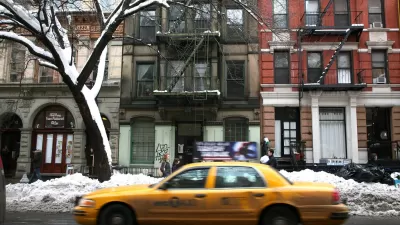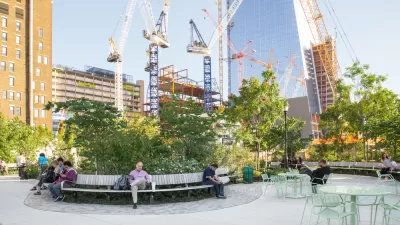We can't build our way out of the housing crisis…but we won't get out without building.
Affordable housing advocates are facing a disturbing new opponent in planning battles across the country: other affordable housing advocates.
Take the battle over implementation of Mayor Bill de Blasio’s proposed Mandatory Inclusionary Housing policy in East New York. The policy would require private developers to ensure that 25 percent of all new housing units are for lower income residents. It is the kind of policy that activists concerned about gentrification have long dreamed of. So it was somewhat ironic that Vickie Been, de Blasio’s housing commissioner, felt compelled to speak out in response to concerns that the plan would cause gentrification and displacement.
Because New York’s inclusionary housing plan is tied to zoning changes, which would allow higher density development along Brooklyn’s major corridors, a number of advocates for the area’s lower income residents have concluded that the plan will add fuel to the booming market and drive rents and for-sale home prices higher than they already are. Been’s response was to remind people that rents were already high and rising and point out that that was the predictable result of a shortage of housing. The new zoning plan, she said, “is not the trigger for displacement; instead, it is a preventative measure.”
A surprisingly similar conflict surrounded a proposed moratorium on new development in San Francisco’s Mission District. The district has been ground zero for the Bay Area’s displacement crisis and Mission activists concluded that a new private housing development was likely to exacerbate the problem by bringing in higher income residents and driving up rent costs. The proposal split the housing advocacy community. Mayor Ed Lee, who has been an unparalleled leader in the fight for more affordable housing funding, and many committed advocates succeeded in convincing San Francisco voters that the moratorium would only make things worse by further restricting supply. The housing shortage, they argued, is the ultimate cause of rising rents and we have to build new housing to make any real progress.
Unfortunately, if we want to work together for more equitable cities, we have to agree on some basic economics. The two sides in this fight see different economic mechanisms behind displacement. One group says prices are rising and people are being displaced because we aren’t building enough housing, while the other group sees new housing development as one cause of gentrification and displacement. If we look more closely, they are not really two different mechanisms as much as the same mechanism working at different geographic scales.
FULL STORY: Luxury Housing Is Not the Enemy

Alabama: Trump Terminates Settlements for Black Communities Harmed By Raw Sewage
Trump deemed the landmark civil rights agreement “illegal DEI and environmental justice policy.”

Study: Maui’s Plan to Convert Vacation Rentals to Long-Term Housing Could Cause Nearly $1 Billion Economic Loss
The plan would reduce visitor accommodation by 25% resulting in 1,900 jobs lost.

Planetizen Federal Action Tracker
A weekly monitor of how Trump’s orders and actions are impacting planners and planning in America.

Wind Energy on the Rise Despite Federal Policy Reversal
The Trump administration is revoking federal support for renewable energy, but demand for new projects continues unabated.

Passengers Flock to Caltrain After Electrification
The new electric trains are running faster and more reliably, leading to strong ridership growth on the Bay Area rail system.

Texas Churches Rally Behind ‘Yes in God’s Back Yard’ Legislation
Religious leaders want the state to reduce zoning regulations to streamline leasing church-owned land to housing developers.
Urban Design for Planners 1: Software Tools
This six-course series explores essential urban design concepts using open source software and equips planners with the tools they need to participate fully in the urban design process.
Planning for Universal Design
Learn the tools for implementing Universal Design in planning regulations.
Caltrans
Smith Gee Studio
Institute for Housing and Urban Development Studies (IHS)
City of Grandview
Harvard GSD Executive Education
Toledo-Lucas County Plan Commissions
Salt Lake City
NYU Wagner Graduate School of Public Service





























